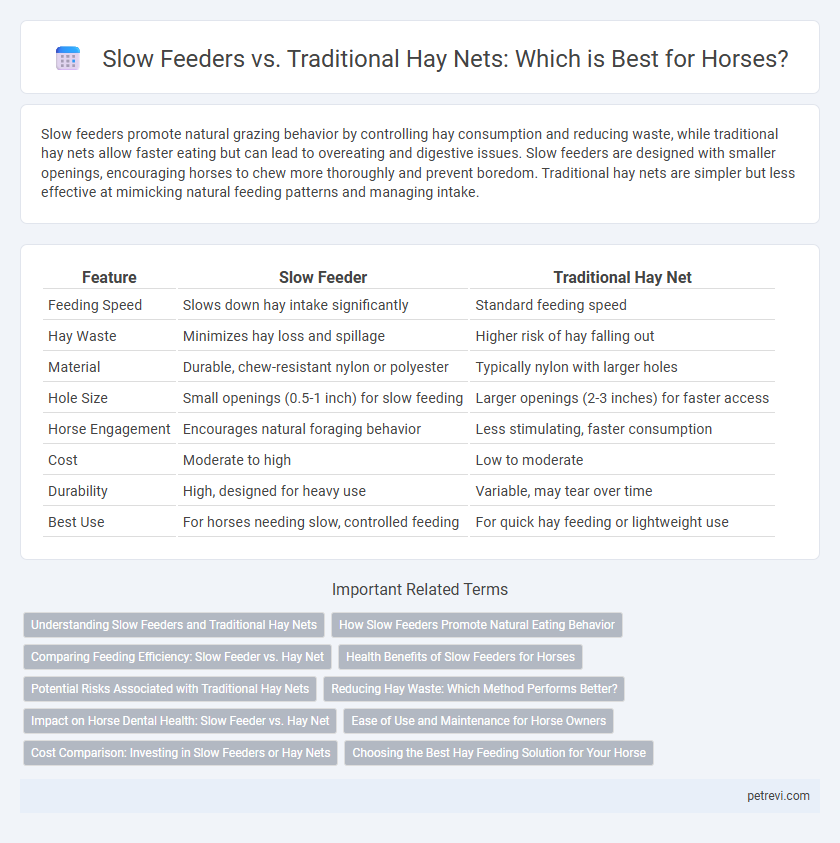Slow feeders promote natural grazing behavior by controlling hay consumption and reducing waste, while traditional hay nets allow faster eating but can lead to overeating and digestive issues. Slow feeders are designed with smaller openings, encouraging horses to chew more thoroughly and prevent boredom. Traditional hay nets are simpler but less effective at mimicking natural feeding patterns and managing intake.
Table of Comparison
| Feature | Slow Feeder | Traditional Hay Net |
|---|---|---|
| Feeding Speed | Slows down hay intake significantly | Standard feeding speed |
| Hay Waste | Minimizes hay loss and spillage | Higher risk of hay falling out |
| Material | Durable, chew-resistant nylon or polyester | Typically nylon with larger holes |
| Hole Size | Small openings (0.5-1 inch) for slow feeding | Larger openings (2-3 inches) for faster access |
| Horse Engagement | Encourages natural foraging behavior | Less stimulating, faster consumption |
| Cost | Moderate to high | Low to moderate |
| Durability | High, designed for heavy use | Variable, may tear over time |
| Best Use | For horses needing slow, controlled feeding | For quick hay feeding or lightweight use |
Understanding Slow Feeders and Traditional Hay Nets
Slow feeders are designed to regulate a horse's intake by limiting access to hay, promoting longer feeding times and reducing the risk of digestive issues such as colic and ulcers. Traditional hay nets allow horses to eat freely, which can lead to faster consumption and potential overeating, posing challenges for horses prone to obesity or metabolic disorders. Understanding the differences between slow feeders and traditional hay nets helps horse owners make informed choices for optimal feeding management and equine health.
How Slow Feeders Promote Natural Eating Behavior
Slow feeders mimic a horse's natural grazing patterns by limiting access to hay, encouraging slower, continuous chewing and digestion. This controlled intake reduces digestive issues like colic and supports mental well-being by preventing boredom and repetitive behaviors. Traditional hay nets often allow faster consumption, which can lead to overeating and increased risk of choke or gastric ulcers.
Comparing Feeding Efficiency: Slow Feeder vs. Hay Net
Slow feeders enhance feeding efficiency by regulating hay intake, promoting slower consumption that mimics natural grazing and reduces waste. Traditional hay nets allow faster access to hay, often leading to rapid eating and increased risk of digestive issues like colic. Slow feeder designs improve digestion and dental health by encouraging prolonged chewing, resulting in better nutrient absorption compared to conventional hay nets.
Health Benefits of Slow Feeders for Horses
Slow feeders promote healthier digestion in horses by mimicking natural grazing patterns, reducing the risk of colic and gastric ulcers. Their design encourages slower consumption of hay, preventing overeating and supporting stable blood sugar levels. Compared to traditional hay nets, slow feeders decrease boredom and stress, contributing to overall improved equine welfare.
Potential Risks Associated with Traditional Hay Nets
Traditional hay nets pose several potential risks for horses, including an increased chance of dental damage due to the small hole size causing excessive chewing. Horses may also experience stress and frustration from slow feeding rates, which can lead to behavioral issues like cribbing or wood chewing. Moreover, these nets can cause entanglement injuries if the horse's hoof or other body parts get caught in the netting.
Reducing Hay Waste: Which Method Performs Better?
Slow feeders significantly reduce hay waste by limiting the rate at which horses consume hay, promoting longer eating times and decreasing spillage compared to traditional hay nets. Traditional hay nets often allow horses to pull out larger mouthfuls quickly, resulting in more hay being dropped and wasted on the ground. Studies show slow feeders can reduce hay waste by up to 30%, making them a more efficient choice for minimizing feed loss and improving pasture cleanliness.
Impact on Horse Dental Health: Slow Feeder vs. Hay Net
Slow feeders significantly reduce the risk of dental wear and uneven tooth abrasion by promoting prolonged chewing, mimicking natural grazing behavior. Traditional hay nets often encourage rapid consumption, which can lead to poor chewing and increased dental problems such as sharp enamel points and ulcers. Implementing slow feeders supports healthier teeth, minimizes the need for frequent dental interventions, and improves overall oral health in horses.
Ease of Use and Maintenance for Horse Owners
Slow feeders offer horse owners easy setup with adjustable feeding rates, reducing labor and mess compared to traditional hay nets. Traditional hay nets often require frequent refilling and untangling, increasing maintenance time and effort. Slow feeders also minimize hay wastage, making them a more efficient and user-friendly option for daily horse feeding routines.
Cost Comparison: Investing in Slow Feeders or Hay Nets
Slow feeders typically require a higher initial investment, ranging from $50 to $150 depending on materials and design, while traditional hay nets are generally more affordable, costing between $10 and $40. Over time, slow feeders can reduce hay waste by controlling intake, potentially lowering overall feeding costs and improving equine digestive health. Traditional hay nets may need frequent replacement due to wear and tear, increasing long-term expenses despite lower upfront costs.
Choosing the Best Hay Feeding Solution for Your Horse
Choosing the best hay feeding solution for your horse involves comparing slow feeders and traditional hay nets based on factors like feeding rate, forage waste reduction, and horse behavior. Slow feeders promote natural grazing patterns by extending feeding time and minimizing boredom, while traditional hay nets may allow faster intake but can increase the risk of choking and hay waste. Consider your horse's specific needs, including dietary management and enclosure safety, to select the most effective and health-conscious hay feeding option.
Slow Feeder vs Traditional Hay Net for Horse Feeding Infographic

 petrevi.com
petrevi.com